It takes about 30 seconds for an average Toronto reporter to throw a headlock opinion on a new draft pick, drag ‘em down into the dirt, and apply the label.
It’s like branding calves, only maybe with a little less bawling.
All a professional hockey reporter needs to form an opinion is one shot, one angle. Just give them one feature they like or dislike, or one guy they can be compared to.
BOOM. They’re branded.
This kid’s TOO SMALL. That one’s FULL O’ GRIT. This guy’s NO KESSEL. That one’s a FUTURE CAPTAIN. This one’s the NEXT WENDEL. And that one’s the NEXT COLBY LOL.
In this business, it’s one and done.
Because the labels last a lifetime, and the media will actively fight you if you try and pull their label off. Remember a few weeks back? This reporter wanted to argue that the new Leafs were too small. So he argued that the Leafs, and the NHL combine, were lying. Why?
Well, because he’d already printed up the TOO SHORT labels, and dammit, he was gonna use ‘em, even if they grew to 6’ 2”.
All right, don’t get all huffy. I know there are some great reporters and analysts out there; people who are far better judges of hockey talent than I. People like Bob McKenzie, who puts in real legwork on prospects, and has real depth to his opinions.
So, to be more precise, maybe I should put it this way: “There sure are a pile of one-eyed, loud-mouthed, shat-bird hockey reporters sticking stupid labels on kids these days. Oh, and a few good ones, too. [Hey Bob!]”
Better?
Anyway, I don’t really want to talk about these guys. They’re not adding much. I want to talk about how the good hockey minds work. That’s the stuff that’s interesting. How the Mark Hunter’s and the Thommie Bergman’s and the people who run the scouting sites that do serious hockey analysis think, and what they see.
What I want to do in this piece is to start the walk from the wasteland, dominated by one-eyed guys with stupid opinions, to a place where we can get a full, two-eyed, multi-dimensional view of a kid, like the scouts get. And maybe even look beyond that, out to where some of them can see potential where even other scouts only see fog and fuzz.
That’s the magic, that is. In any field, that’s what’s really interesting, not sitting and arguing with idiots about whether some kid is 5’ 10” or not.
*
So, here’s where we’ll start—with this idea:
That the world you see out of your right eye is not the world you see out of your left.
Because, really, it’s not.
It seems like a small thing, that little gap between our eyes. But just those few inches mean that our eyes feed our brain two slightly different perspectives on the world.
It’s how we humans are built.
We’re actually built in such a way that we give ourselves different perspectives about reality, as though our bodies are deliberately creating arguments for our brain.
Except then our brain actually feeds off the difference: It takes those two perspectives, drops them down one over top of the other, and actively studies them to find the differences, the mismatches.
Once it finds them, our brain takes those differences and—this is the magic bit—it translates them.
Into depth perception. A world of 3-D vision.
Gregory Bateson wrote about this 30 years ago, and [Warning: shocking personal revelation ahead] I actually read the book. Remembered it, even. Bateson pointed out that if each eye fed the brain exactly the same information, well, we’d learn nothing new by having two eyes instead of one.
But separate those two eyes by a few inches, and you get better depth perception. You start to see edges instead of a blur. You can pick things out that are in a shadow.
Give your brain an inch, and it’ll give you back a world.
A world in 3-D.
*
So, in this post, rather than babble on in general or whine about overweight reporters who complain about underweight kids, we’re going to look specifically at two young Leaf prospects.
To test our “two eyes –> depth perception” theory, we’re going to look at each through two slightly different perspectives.
The left eye’s perspective will focus in tight on our first prospect and small group of his peers – and then compare them by how often they scored.
While the right eye will give us a somewhat broader perspective on a second prospect’s background and career trajectory – and then look at how he scored.
After we generate these two information streams, we’re going to bring them together, and overlay them for comparison. Some areas will mismatch, and show up as differences, which we’ll jiggle around a bit to sharpen the differentiating features between the prospects.
The idea is that this binocular method – just as with human vision and depth perception – will then help us see more of the prospects’ potential that is otherwise hidden or blurred.
Who knows? If we’re lucky, maybe we’ll get to see one of those big talent, late round “home run” kids step out of the shadows.
Like the way Shoeless Joe stepped out of that field of corn.
*
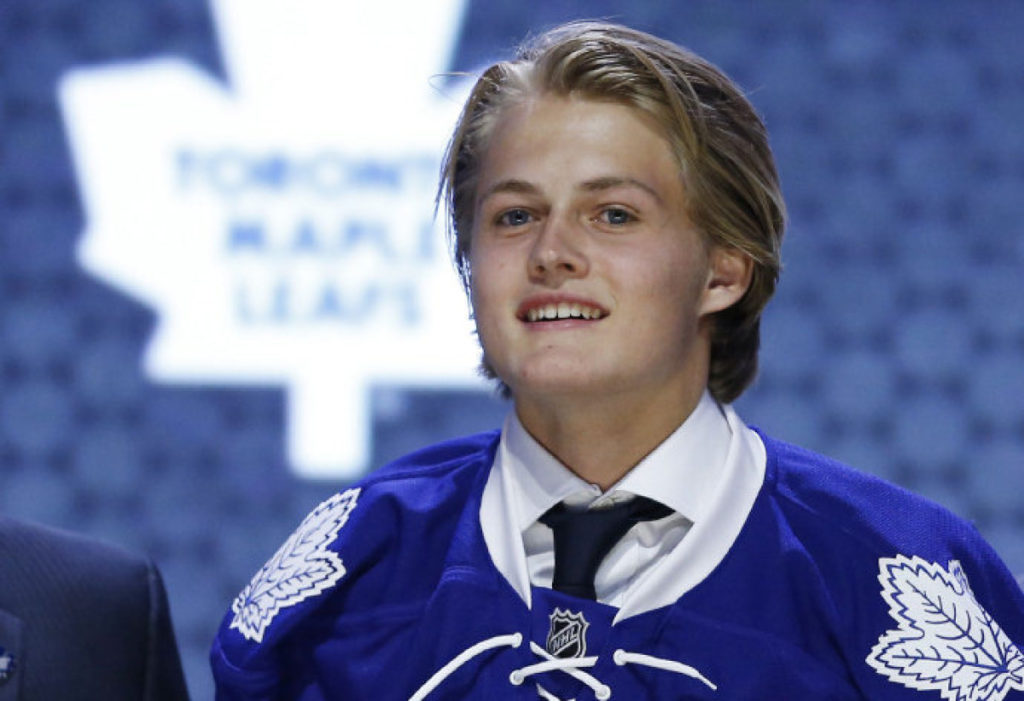
The 2014 Draft saw some amazing high-end talent come out of the Swedish junior league. For starters, five young forwards were picked in the first round. The Leafs picked the best of this crop, getting William Nylander at #8.
But there was also a sixth kid who played with or against all the others. A year or so later, the Leafs found a way to swing back and pick him up as well.
This sixth kid is going to be our first prospect in focus. The perspective we’re going to generate here will come by comparing this kid with the other five picks.
Now, we’re not going to identify our two prospects by name. The idea is to avoid preconceptions as much as we can, to see them as new. But, since these kids are Leaf prospects, they’ve already got labels and been assigned loads to bear. For now, we’re going to keep this sixth kid cloaked and nameless, to see his capabilities free from the media and their sticky paws.
Okay, he needs a temporary name. I’m gonna call him…
Nitro Mysteron.
Because…. Well, frankly, if I’d ever had a son, I always wanted to name him “Nitro Mysteron MacKeen.” As have most of you, I’m sure. And for those of you who don’t like the name — go get your own prospect.
You can name him Patches… or Semin… or Patches of Semin… or whatever makes you and your little Hab friends happy.
*
We’re going to kick off our look at this group with a fairly brass-assed summary of William Nylander. Now, most Leaf fans know what the numbers say about this kid, but it seems they’re basically afraid of saying it out loud for fear of jinxing him. Just this once, we’re going to let the facts speak for the facts.
William Nylander isn’t just squeezing into the Top 10 scorers, or merely outscoring his entire age group. He’s outscoring everyone his age that’s played for 10 or 15 or 20 years. And he’s doing this every year, in every league.
- In Swedish Junior: Nylander scored at a 1.6 Points Per Game (PPG) pace. Faster than any 16 year old in a decade. Faster than Landeskog, the Sedins, Filip Forsberg, or Gustav Nyquist.
- The Allsvenskan: He then went on to the Swedish AHL-equivalent, where he scored faster than any 17 year old ever. Faster than Forsberg and Pastrnak and Burakowsky and Backlund and, well… everyone, right?
- In the SHL: he scored faster than any 18 year old had in 20 years. Faster than both Sedins, Anze Kopitar, and Peter Forsberg. Look, he scored faster than Mats Sundin, and he did this on a disastrously bad, last-place MODO team.
- AHL: After Nylander ran out of runway in Sweden, he got called over to the AHL. A mid-season change of language, team-mates, rink size and so on is not easy. The result? Well, in 37 games he scored more points than any 18 year old had in five years. He upped his scoring rate every. single. month. as he adjusted, rising from 0.5 to 0.6 to 0.9 to 1.3 PPG — just as he had scaled up his scoring rate in the SHL. He finished the season with 15 points in the last 10 games.
- International: At every age — 17, 18 and 20 — Nylander has scored more than 1.4 PPG at the Worlds. Pause on that and hit replay for a second: At every age — 17, 18 and 20 — Nylander has scored more than 1.4 PPG at the Worlds. He was the top scorer at the World Under 18’s, and just one point off the lead at last year’s World Junior Championship.
Now, Shanahan and Dubas and the new Leaf management [Hey! Lou!] get paid to be clear-eyed and forward-looking about these questions. And, clear-eyed, they know that a kid who outscores everyone his age for 10 or 20 years back tends to come along about once in, ohhhhh… every 10 or 20 years.
Which means, when they look forward, they know they need to identify—and secure—young, low-cost talent that can play up with a player like Nylander.
NHL history is full of top-end players who were never given capable line-mates. You Leaf fans may remember that big Swedish centerman we had, and all his lousy wingers.
Now, I’m mentioning this because I am stone cold certain that Nylander was part of the reason why the Leafs obtained our sixth kid. So, let’s note that getting Nylander helps explain why we found and targeted Nitro.
Once we see that Nylander looks to be really seriously a top-end prospect—like a once in every 10-20 years good—that also helps us establish a measuring stick against which we can compare young Nitro and the others.
*
The other four kids taken in the first round from Swedish Junior turn out to be no slouches:
- David Pastrnak was a favourite line-mate of Nylander’s. Picked #25, he broke almost immediately into the Bruins line-up. Just 18 years old, he scored 27 points in 46 games. He’s also scored well in the Czech league, in Sweden, at the World Juniors, and in the AHL. Best of all, strict Bruin policy requires that Pastrnak be traded by age 22.
- Adrian Kempe was L.A.’s #29 pick, and played with Nylander at MODO. At 6-2, he’s taller than the others, and more physical. He followed Nylander’s path up through Jrs, the SHL, and landed in the AHL in time for a great playoff run – 8 goals in 17 games – while his team won the Calder. Kempe then signed a three-year deal with the Kings, and will likely soon see NHL action.
- Kevin Fiala (#11 Nashville) and Jakub Vrana (#13 Washington) had the same trajectory: Swedish Junior to SHL to AHL. Fiala had a strong 33 games in the AHL, scoring 11 goals, and is in Nashville now training for the Fall. Vrana had a strong full SHL season, and came over to the AHL and put up six points in ten playoff games.
Given that these kids are all just age 18, that’s an incredible concentration of talent.
Note the trajectory: All five picked in the first round, exploded out of Sweden and into North America — where they will almost certainly make the NHL — and are good bets to make it in their teens.
This is the quality, and the trajectory, of Nitro’s five peers.
*
By comparing their Junior performances – and keeping in mind their trajectory since – we should get a sharper sense of the potential our sixth man, young Nitro Mysteron:
1st: For starters, Nitro is the youngest of the group by an average of 6 months.
2nd: While the media aren’t convinced he’s all that large, he actually weighs more than all the other five, e.g. he’s 25 pounds heavier than Pastrnak. So, no, he’s not tall, but he isn’t thin.
3rd: At age 16 in Junior, he scored more points than anyone his age or younger, and the most anyone his age had scored in 15 years. The next year, he finished second for points for his age-group, and tenth all-time.
Now, those numbers are more than good, but I’m happier dealing with Points Per Game, looking at a player’s exact age, and seeing their names — context that helps sharpen what we see in their point stats. So, I created some PPG charts from Junior to compare Mysteron with some peers.
4th: Starting with those five first round picks, it turns out that Nitro out-scored four of them and lagged behind only Nylander. That’s a bit of a big deal, outscoring four top first round picks on the fast track to the NHL.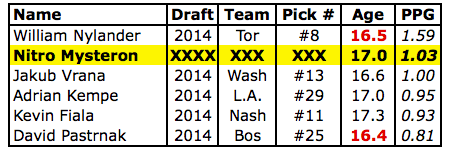
5th: Leaf fans will also want to compare Nitro to our other recent picks from Sweden, which shows him behind Nylander but out-pacing Andreas Johnson and Alex Steen: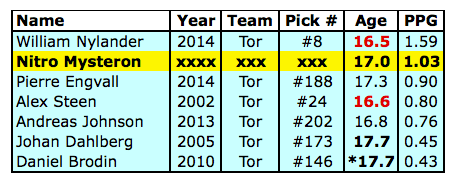
6th: Lastly, I like to compare players across the years, with their ages brought roughly into line (asterisks mark where seasons were merged to bring ages into line, and red highlights players who were extra-young). The lists don’t tell us how well a player will necessarily do, but they can help us gauge their top-end potential.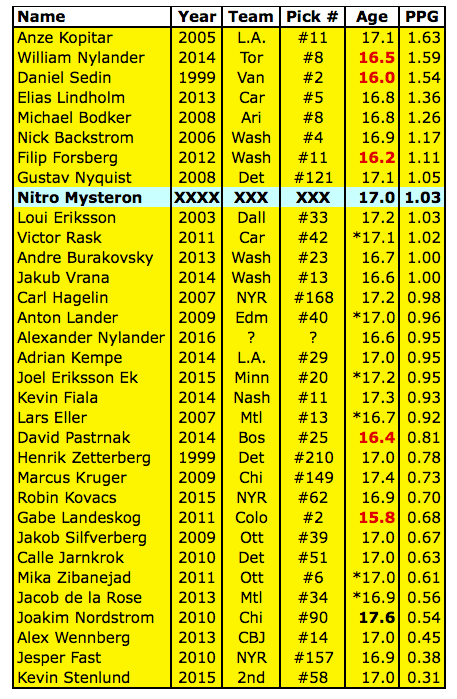
For starters, let’s make sure to dampen any unnecessary hype here. The Mysteron – while very good – still clearly ranks below the dominant young talents out of Swedish Junior: The Sedins, Kopitar and Nylander all scored 50% faster, for example.
But he did actually produce as well or better than Gustav Nyquist, Andre Burakovsky, Victor Rask, Carl Hagelin, the four other first rounders, and the 2015 draft’s top pick from Sweden, Joel Eriksson Ek.
He appears to be a much more capable scorer than Kruger, Fast, de la Rose and others, given that he’s scoring twice as often.
Which is probably not a bad summary of this first perspective:
As a scorer, Nitro is a clear notch below Nylander and other top talents like Backstrom, the Sedins, and Kopitar. But he’s right in the mix with all the other 1st round picks from Swedish Junior over this last decade, and in particular, with the top-notch talents picked in 2014.
*
For our second young prospect, our perspective will take in more of his personal background and trajectory. We’ll look less at how often he scored, and more at how he scored.
1st: Our next prospect is the son of a rather famous sporting father. Except the sport isn’t hockey; it’s Greco-Roman wrestling, where his Dad was Russia’s National Wrestling Champion, a genetic background that should help our prospect fill out.
It also explains why I named our second young prospect “The Russian Rock,” after his father.
But also in honour of The Rock, probably the greatest wrestler and movie star ever. And also — true story — The Rock is actually the son of the great Nova Scotian wrestler, a guy named “Rocky Johnson,” whom I watched with his famous Flying Dropkick every week on TV growing up.
GET HIM, ROCKY!
*
2nd: Sadly, however, the Russian Rock’s story unfolds with his parents parting, and he has to move to another country. So he starts hockey relatively late — age 8 — but by 14 his hockey skills are blazing, and he’s already playing up against 18 year olds.
Age 17, he’s hit the top of European Junior and faces a choice. He can stay at home and take the easy route into the European pro leagues, or he can go to the NHL, which is what he wants. The best prep for that, he determines, is a year of North American Junior before the draft. So, off he goes to play in the Q.
3rd: Sure, for most people choosing to move to Quebec is a bad life-decision. What with the halitosis, the smell of burning cop cars in the morning, and the in-Habitants flopping on the sidewalk every time they’re bumped.
But our young Russian Rock doesn’t waver. He doesn’t shake. Sure, he now has to learn French, his fourth language, and his family, friends and entire personal support network has been left behind. He knows no one. He also has to learn the North American game, and play on the smaller ice.
Doesn’t matter to the Rock.
*
4th: In his 1st full month in North American hockey, he’s named 1st star in the Q.
FLYING DROP KICK!
Here’s what the press said about it.
“A hard worker, (he) immediately gelled with his teammates and has been a fun guy to have in the dressing room. (The Rock)’s coach says, ‘Sometimes you want to be patient with import players and give them a month, month and a half to adjust. He adjusted on Day One and his personality made him do that.’”
5th: Now, maybe it’s because this kid has always been an outsider and had to learn how to play with others, and learn to speak their language. Whatever the cause, he turns out to have a knack for sharing the puck.
In other words, he collects assists like candy.
More assists than Timo Meier or Evgeni Svechnikov or Anthony Beauvillier – all first round picks in 2015. He also did pretty well when compared to other great playmakers from the Q in their draft years, with more assists and a faster pace than:
Claude Giroux. Jakub Vorachek. Nik Ehlers. Mikhail Grigorenko. Jonathan Huberdeau. Nathan MacKinnon.
In fact, the last draft age kid in the Q to get more assists than our Russian Rock was…
Sidney Crosby.
That’s a seriously world-class level of playmaking ability.
6th: Now, I know what you’re thinking. Okay, wait. Actually, no, I don’t. Because I’m not a g*ddamn mind-reader, okay? Still, I’ll bet some of you think this is just another kid from the Q that racks up a million power-play points, but can’t play worth a damn at five on five.
Well, here are his 5v5 numbers against the draft picks from the Q this year — Svechnikov, Timo Meier, and the rest.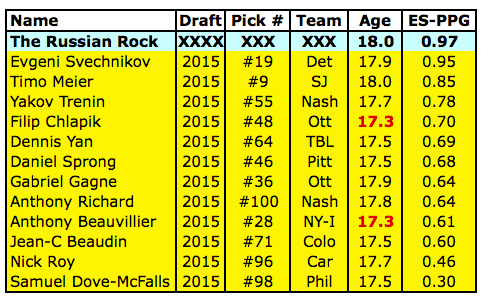
BODY SLAM!
Yeah, that’s a pretty dominating performance.
This kid scored better at five on five than every draft age kid out of the Q this year, and in many cases, waaaay better. As in, 50% better.
7th: Here are his 5v5 numbers against previous big name picks from the Q.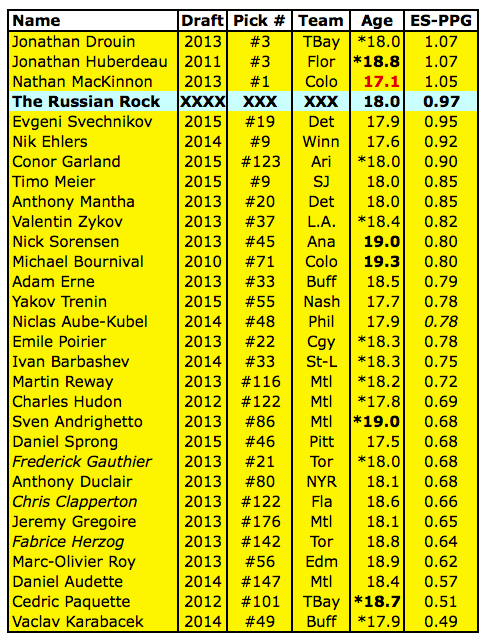
But again, just to be safe, let’s make sure the hype train doesn’t run off the rails. Our Russian Rock had a great first year in the Q, but not at the level – or at the young age – of a Nathan MacKinnon.
Still, it’s damned impressive to score more five on five than Nik Ehlers, Anthony Mantha, and Anthony Duclair. One scout called him, “Consistently the most dangerous forward in the Q.” Another called him, “Arguably the most dangerous player in the Q.”
Which does make him sound, errrrm, a bit…. dangerous, doesn’t it?
And he did all this as a rookie.
And yes, thanks for asking, he also outperformed the 1-2-3-4-5-6 Hab prospects I somehow listed, almost as though I was intending to rub salt in the wounds, when nothing could be closer to the truth.
8th: Okay, let’s close with a qualitative slice, and listen to the scouts on his skating.
Pronman: “Fantastic skater, explosive acceleration and speed.”
Future Considerations: “Electrifying… very fluid skater… everything with this guy is at top speed…”
Elite Prospects: “… His explosiveness opens up space… a dangerous player that will shock audiences with his speed and creativity….”
MacKeen’s: “… He uses impressive speed to create chances off the rush.”
Now, these are only summaries, but they sure sound as though the scouts rate his skating as above average.
So how would we sum up this second perspective on the young Russian Rock?
He skates fast, he learns fast and he’s driven. He can walk into new worlds and come to terms with them quickly. A helluva playmaker, in straight-up 5v5 play he out-scored the entire 2015 draft class from the Q.
*
Two prospects. Two different perspectives on each.
1. Nitro Mysteron, who out-scored all the high-flying first round Swedish picks except Nylander, who was scoring at a once-in-a-decade pace.
2. The Russian Rock, the multi-lingual wrestler’s son who came over and absolutely smoked his rookie season in the Q, including in head-to-head, 5-on-5 play.
Now, our original idea was to take in these two perspectives on each, and then compare them. To give the pictures a bit of a shake back and forth, to see if anything new stepped out — maybe even some of that hidden potential the Leafs believe they’ve spotted in these kids.
So, first let’s do the unveiling. We all know the rules.
Two men enter. One man leaves.
And so, Nitro Mysteron… is Dmytro Timashov in Sweden, in 2013/14.
Whereas the Russian Rock… is Dmytro Timashov in Quebec, in 2014/15.
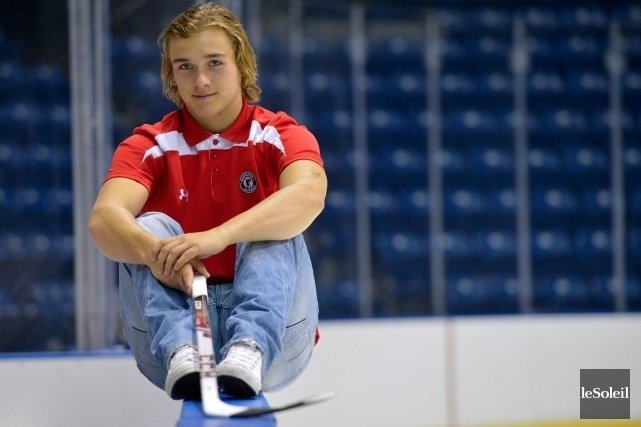 A trick, I admit, since I pitched it as two prospects. The aim, though, was to sidestep any preconceptions; to give two slightly different perspectives, with the hope that when they came together at the end here, they’d help us see new depth, and new potential, in Timashov.
A trick, I admit, since I pitched it as two prospects. The aim, though, was to sidestep any preconceptions; to give two slightly different perspectives, with the hope that when they came together at the end here, they’d help us see new depth, and new potential, in Timashov.
**
To start with, both perspectives found that Timashov has certain talents and features of his game that showed up in common.
So, let’s start with that core: The skills the Leafs will have seen from BOTH perspectives, on both continents.
- He’s a world-class playmaker and creator. He led all Swedish Juniors his age or younger in assists, then did the same in the Q. Those are two systems famous for the playmakers they’ve produced, and Timashov just out-produced all his competitors.
I - He can play up at the level of the most talented players. He helped both Nylander and Kempe thrive, and then Erne and Duclair.
I - He can play against tough competition. The Leafs saw him perform well at the Memorial Cup against Leon Draisaitl, Josh Morrissey, Nick Merkley, Michael Dal Colle and others. They’ve also seen him in International play for Sweden, averaging over 0.8 PPG.
I - He’s driven. From Sweden, Leaf scouts knew he had already handled moving to another country, learning a third language, and picking up hockey late. And they’ll have seen that this kid hasn’t been handed any privileges. In fact, as the son of a single mother and an immigrant, he’s always had to learn it, and earn it.
This year, the Leafs will have gotten a different perspective on him. That would have let them see the ways in which his game grew and changed under the different conditions, and would have added to the Leafs’ sense of his potential. For instance:
- He thrived in the North American game. Timashov grabbed the North American game by the horns and shook it. The first star in month #1, he was named Rookie of the Year by season’s end. He didn’t just “handle” the smaller ice surface and the faster pace and the hitting, he out-scored everyone when the game was at its toughest and most crowded during five on five. At the Memorial Cup, he scored two goals against Oshawa, and had four points in five games over the duration of the tournament. A strong performance, overseas and under pressure.
I - He’s physically and mentally resilient. Timashov – in his first year here – not only handled the long North American season, he played in 22 playoff games, including a seventh game Final, followed by the Memorial Cup. That’s a total of more than 90 Games Played, with over 110 points scored, in his first year in North America. Through it all, he didn’t get busted up because he was too small, or step aside because he was Swedish.
So, having seen his core talents reinforced and deepened — and then these new features added — I think that was enough for the Leafs to feel Timashov was a kid with tremendous potential.
*
In fact, Timashov’s fall at the draft was an almost textbook example of how a young player’s potential can get lost in the shadows. Let’s count the ways in which the full information about Timashov got lost, broken or blurred:
- He was born October 1st, two weeks too young to be drafted with Nylander and the 2014 group. For scouts seeing him just this year in the Q, he would look like a “relatively old” pick for 2015.
- His junior career got broken across two continents. Two different sets of scouts saw him, and in different years. So, inevitably, some information gets lost, and some fails to translate.
- The Russian factor. People hear the name and think “Russian,” and that overrides the fact that he’s a Swedish citizen and has a Ukrainian Mum.
- In Sweden, he was a Ukrainian-Russian immigrant, which reduced his chances to be named to national teams for international experience.
- He looks short, and is short, except that he’s now 192 pounds — not that small for age 18. If you knew the wrestler’s son background, you might expect him to fill out further. Nonetheless, a lot of teams will filter him out as “5-10.”
- He played in the Q, and if you hear about a kid who’s small, older, racks up a lot of assists, and is in the Q… well, there are preconceptions, right? Like, that he’s also soft, a powerplay specialist, etc.
That’s six major ways information about a kid can get lost; six ways fuzz and fog was generated. In behind all that was Dmytro Timashov.
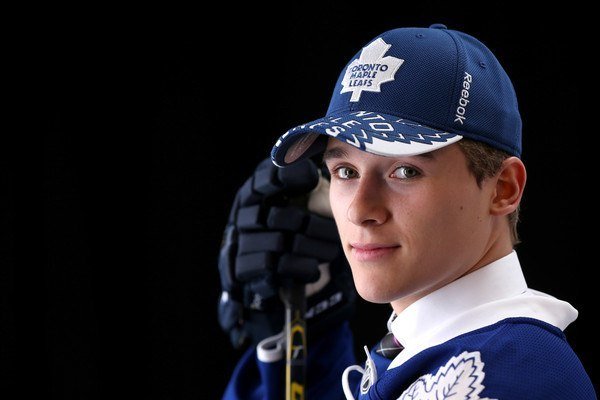
**
So how did the Leafs gain their additional perspective? How did they get that perspective that let them see him in depth, with sharp edges and clear potential?
1st: Thommie Bergman. By scouting Nylander in 2012-14, Thommie would have seen Timashov play dozens of times, including on the same line. He’d have seen that the two played well together, and that Timashov had the talent to play up. So, this year, when Leaf scouts – including Hunter – saw Timashov in the Q, and talked to Thommie, he’d have plenty of in-depth info, including the puzzle piece about playing with Nylander.
2nd: The Nylanders. Timashov was not only a teammate of Nylander’s, but asked him about coming to Canada, where Nylander “spoke very positively of coming over.” Plus, Brendan Shanahan played with Michael Nylander on the Rangers, which means if the Leafs wanted up-close, personal insight into Timashov, his capabilities, intentions and habits, they had it. They’d know if he planned an NHL career, or saw it mostly as leverage for the KHL, and so on. That’s two inside perspectives.
3rd: Statistics. Mark Hunter’s described Timashov as, “A puck possession player that can really handle the puck…. He can make plays, he can pass. Good skills.” Now, we know Leaf management values puck possession, and is gathering more of these stats on Junior players. When Hunter says Timashov is a possession player, that’s likely based on some stats, not just a comment. Similarly, we hear Leaf scouts highlight how many even-strength points players score – another area where Timashov shines. Some key Leaf statistics were likely casting a positive light on Timashov.
When you add those additional perspectives to the mix, a series of blurry areas and question marks about Timashov are cleared up.
- The size: If you know Timashov’s family and family history, and see that he’s adding weight and is up to 192, his size becomes less of a worry. Mark Hunter provided context to this, about Tyler Johnson, “He’s 5-foot-7, but weighs 185. He’s built…. He doesn’t have the height, but he can get by because he has the weight.”
I - The Russian question: Yes, Timashov’s Father was Russian, but the Leafs know his Mother is Ukrainian, know he lived in Sweden for years, know he learned English, and likely know whatever the Nylanders know.
I - Soft points: They’ll have seen, from two countries and backed up by the stats, that Timashov is not simply getting his points as a powerplay specialist, but is extremely strong at even strength and an excellent puck possession player.
Now, the Leafs will see that Timashov has a lot of potential, but they’ll also have no illusions that he’s a Nylander or a Marner, a MacKinnon or a Forsberg. He’s not.
But, how about the tier below that? With Fiala and Vrana and Kempe and the Swedish first rounders, and Meier and Duclair and Gauthier from the Q? Well, there’s no reason they won’t want to see him competing in there.
The Leafs know that that calibre of talent usually has to be paid for in the currency of a first round pick, or by trading away an established NHLer.
So they’ll be thrilled to get this kid where they did.
I know I was.
**
One last fact I liked: Timashov’s youth team was apparently Sollentuna, which has only ever graduated one forward on to the NHL.
Kid named Sundin.
































